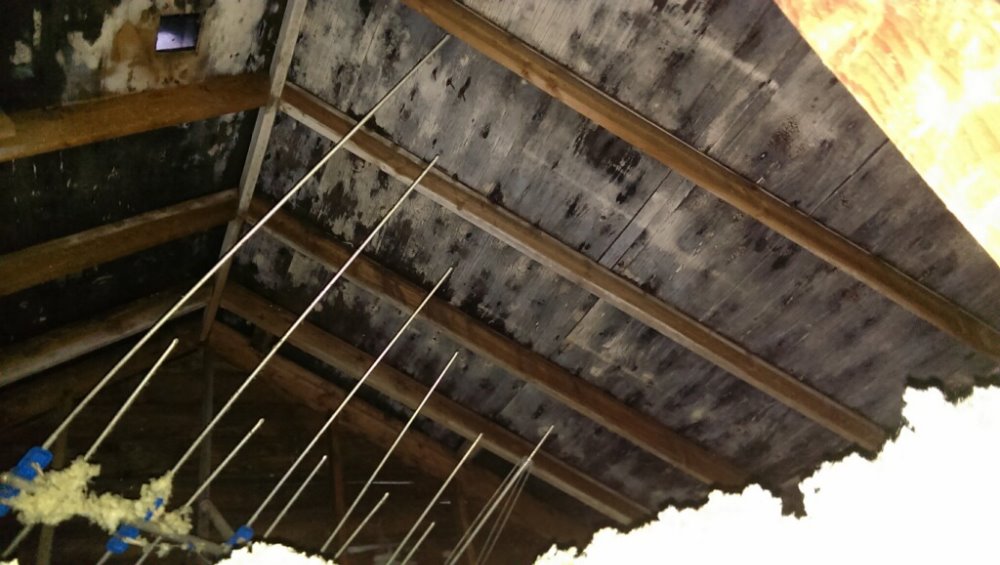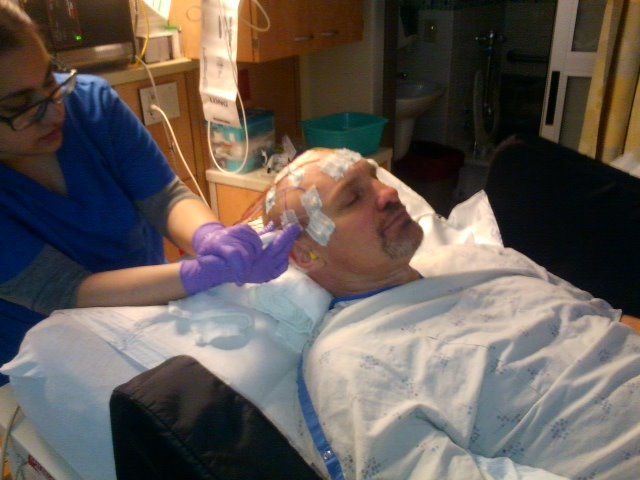
Raise the Roof for Johnson's
Donation protected
Like most people living in older homes, Craig "Charlie" and Shelly Johnson assumed the slightly musty smell in the house was just what comes with owning an older home. Since candles had always done the trick over the years, quickly and easily freshening the air, they hadn’t considered the possibility that the smell might be a sign of something toxic and dangerous to their health.
On July 8, 2014, after more than a decade of rapidly and dramatically declining health for them both, and very few answers as to the potential causes, Craig and Shelly learned that the attic and basement in their home was covered in white and black mold tested at “Condition 3,” which is the highest and most toxic level.
Although this discovery finally gave Craig and Shelly some insight into the health problems that for years have confused countless healthcare professionals, it also meant that they were forced to walk away from their family home. After years of serious health decline that has caused tremendous heartache over the loss of work, countless diagnostic procedures, surgeries, and medical costs leading to bankruptcy, this mold would now also take their home. In a cruel twist of fate, their insurance claim was denied due to a “mold” exclusion in their homeowner’s insurance policy, an unknowingly common exclusion in most insurance policies. The medical effects of inhaling mold at this level not only robbed Craig and Shelly of living the healthy, social lives they had always lived, but for years now it has required them to remain at home - the very place causing the damage.
Here is their story:
Craig and Shelly Johnson, married for 32 years and a couple since they were in high school, bought a home in 1990 in Vancouver, WA that they considered an ideal place to raise their two sons. Sitting on a large, beautiful lot, they remodeled their home in 1996, finishing their basement and adding both a bedroom and bathroom to accommodate their growing sons. Over the years, Craig and Shelly’s home has been the gathering place for family and friends to celebrate important occasions and holidays.
Shelly’s Deteriorating Health
Approximately ten years ago, Craig, Shelly, and both of their sons began noticing changes in their health, with an onset of physical symptoms ranging from asthma to chronic pain. Each of them over the past decade has battled various chronic respiratory infections, including bronchitis, pneumonia, and asthma. Shelly began to notice that she was feeling extremely fatigued, a highly uncommon experience for someone who had always been vigorous and energetic. Shelly also began experiencing chronic headaches, muscle and joint pain - to the point that some days it was a challenge to get out of bed - and intermittent periods of confusion. She saw multiple medical specialists seeking a diagnosis and treatment for these increasingly debilitating symptoms. In 2007, the pain and spasms in her back had become a chronic struggle, so much so that Shelly was unable to care for the children in the daycare she managed, forcing her to quit work that she loved.
Shelly’s declining health had affected every aspect of her life, leaving she and her family and friends scared, confused, and deeply worried about what might be causing her decline. With a lack of mobility, in chronic pain, and easily fatigued, Shelly was now forced to spend most of her time at home. She continued to seek a medical diagnosis with various specialists, and after receiving more than 30 injections in her spine to relieve her severe back pain and spasms, tests for Multiple Sclerosis, Lyme disease, and Lupus, among others, Shelly was diagnosed with Fibromyalgia, rheumatoid arthritis, auto immune disorder and chronic pain disorder (unspecified).
A couple of years passed, with no improvement in Shelly’s health. In 2010, she had a spinal cord stimulator implanted in her back to relieve the pain. Unfortunately, during the procedure her spinal sac was torn, resulting in piercing headaches for fourteen weeks. One of the leads from the stimulator soon became displaced, and a second surgery 7 months later was performed. Shortly thereafter, in 2011, a small tumor was identified and removed from Shelly’s spine.
The following year, with little hope that anything would end up helping Shelly’s pain and symptoms, Craig and Shelly switched medical insurance companies. Their new insurance company recommended a removal of the stimulator. On this recommendation, Shelly underwent the surgical removal of the stimulator in 2012, and has since been prescribed a medication regimen seeking to relieve her pain and provide some quality of life and mobility. Shelly still experiences very painful muscle spasms and a nerve twitch in her foot, which her physician has told her is due to irreversible nerve damage.
Craig’s Deteriorating Health
Craig, who also goes by “Charlie,” has long been strong and active, working outside at Yard ‘n Garden Land, and doing intense landscaping work for many years. Full of life, and one who has loved to throw parties and gather others together, Craig has always been the one who has organized vacations, celebrations, and fundraising events for those in need.
Although his symptoms have differed than Shelly’s, Craig has also experienced dramatic changes in his health. Over the years, Craig would experience periodic bouts of pneumonia and other extended illnesses, requiring him to miss weeks of work on occasion. This was assumed to be a byproduct of a slightly compromised immune system due to his years of working outside in the weather. Like Shelly, Craig also noticed that he was feeling far more acute muscle and joint soreness than was typical.
Initially these symptoms were thought to be a consequence of stress, not only from his concern for Shelly and her health, but also due to mounting medical bills. After years of diagnostic tests, and failed treatments seeking to alleviate some of Shelly’s chronic pain, Craig was forced to withdraw his retirement to cover their medical costs, and eventually he and Shelly filed for bankruptcy protection so that they might have a chance to keep their home.
Despite years of illness and poor health, and the drain this had caused in every aspect of their life, it was a point of pride for Craig and Shelly to remain current on their mortgage payments. That has been a challenge for them for many years now. Over these past couple of years they have worked to modify their mortgage, all the while never missing a payment. In the end, their diligence in making their payments each month led to them being denied a loan modification.
The past two years, Craig’s symptoms escalated considerably, such that he was now experiencing severe headaches, depression, extreme fatigue, and increasingly painful joint aches. Craig’s healthcare providers had a difficult time accounting for his symptoms, so Craig elected to be proactive and work to help himself. Craig went to counseling to address his depression, began running and losing weight, and eliminated alcohol and red meat from his diet. As with their mortgage, Craig worked to do his part, giving every effort possible to improve his health. Sadly, despite Craig’s many efforts and discipline in changing his lifestyle, his symptoms continued to get worse.
Craig was beginning to experience periodic working-memory loss and confusion, to the extent that he would get lost and confused driving to and from work on a route that he has driven daily for over 20 years.
As with Shelly, family members and friends were deeply concerned by Craig’s health, and scared at what this symptoms might mean. Craig was quickly referred to a neurologist and admitted to OHSU for a four-day examination and observation period. After ruling out a seizure disorder, Craig underwent a thorough neuropsychological assessment to evaluate his cognitive functioning, particularly those mental faculties associated with the recent impairments he had been experiencing. At the end of Craig’s evaluation, he was diagnosed with Trigeminal Autonomic Cephalalgias, a condition characterized by severe and chronic pain from the trigeminal nerve in the brain.
This diagnose unfortunately did not change much in Craig’s life. In 2013, Craig was put on oxygen, as his physician theorized that Craig was perhaps getting too little oxygen to his brain, and that this might account for his symptoms. Unfortunately, despite the oxygen treatment, Craig’s health continued to decline. Over the past year, Craig has been unable to recall holidays and special occasions, just weeks after they had passed, and he now struggles to remember the names of customers he has known and worked with for years. When he has been able to work, Craig struggles to work beyond a couple of hours each day due to extreme fatigue, piercing headaches, the acute weakness in his arms and legs, amongst many more debilitating symptoms.
Mold Report
During the last week of May, Craig was physically unable to get out of bed. He went back to his physician, and also sought the additional help of an acupuncturist. Craig’s physician, the most recent of many, noticed that Craig was experiencing symptoms associated with heavy metal poisoning, and had Craig tested. The results indicated heavy metal poisoning was not the cause. Provoked by the similar timelines of Craig and Shelly’s health deterioration, this physician decided to speak to both of them about their symptoms and health, suggesting that they have their home tested for potential toxins.
On July 8, 2014, Craig and Shelly had their home tested for toxins, and was informed by the specialist that they had the worst mold problem she had found in such a clean home. The attic is completely covered in black and white mold. It was soon learned that when the home was remodeled in 1996, the bathroom vents were never hooked up, and the side vents in the attic of the home had been covered with siding. Therefore, the moisture from thousands of showers over 18 years had remained trapped in the attic, creating a highly toxic breeding ground for mold. The company sent the gathered sample to a lab specializing in mold testing, and the lab report indicates that the attic is at “Condition 3,” which is the highest and most toxic level. Severe levels at “Condition 3” of mold were also found in the basement. The family has thus been unknowingly inhaling the most toxic level of mold spores for years, within a beautifully decorated home. The slightly musty smell in the home was believed to be a natural consequence of owning an older home with a basement, and so candles have been burned consistently over the years.

Next Steps
This news was just the most recent chapter in a heartbreaking sequence of events that has irreversibly altered the lives of Craig, Shelly, and their family. Craig and Shelly were advised to immediately move out of their home, and into the small apartment that was built for Shelly’s mother. Naturally, they contacted their insurance agent, who shared the demoralizing news that their claim had been denied due to a mold exclusion clause. More than twenty years of home insurance payments, and their mold is not covered! Neither the home nor their contents are covered, and mold experts informed them that their furniture could not be saved.
Craig and Shelly have since received varying opinions on what to do with the home, but given the limited research currently on procedures to safely and effectively remove mold, it appears certain that the home must be completely taken down.
Reactions to environmental toxins such as mold can differ from person to person, so Craig and Shelly’s physicians cannot predict with much certainty how and to what degree the years of highly toxic mold exposure will continue to impact their health. However, given the number of years, and the pervasiveness and toxicity of the mold in their home, Craig and Shelly’s physicians have informed them that their nervous systems have likely been irreversibly damaged.
The pictures below are of the transformation that being exposed to toxins can do to a body and your health.
Our friends and family have spent years praying and wishing them well. Now we have an answer and it is time to "do something". We have started a non profit company called "Raise the Roof Foundation" where every dollar donated to the end of this year will go to get Craig and Shelly into a healthy home and pay their medical bill. This couple has suffered silently and have helped so many others in need.
If you are able to donate, no matter the size of the donation, every dollar is appreciated. Craig and Shelly are now on the road to recovery, but it is a long, expensive road ahead to clear these toxins out of their system and to get them into a healthy clean home.
Thank you!






On July 8, 2014, after more than a decade of rapidly and dramatically declining health for them both, and very few answers as to the potential causes, Craig and Shelly learned that the attic and basement in their home was covered in white and black mold tested at “Condition 3,” which is the highest and most toxic level.
Although this discovery finally gave Craig and Shelly some insight into the health problems that for years have confused countless healthcare professionals, it also meant that they were forced to walk away from their family home. After years of serious health decline that has caused tremendous heartache over the loss of work, countless diagnostic procedures, surgeries, and medical costs leading to bankruptcy, this mold would now also take their home. In a cruel twist of fate, their insurance claim was denied due to a “mold” exclusion in their homeowner’s insurance policy, an unknowingly common exclusion in most insurance policies. The medical effects of inhaling mold at this level not only robbed Craig and Shelly of living the healthy, social lives they had always lived, but for years now it has required them to remain at home - the very place causing the damage.
Here is their story:
Craig and Shelly Johnson, married for 32 years and a couple since they were in high school, bought a home in 1990 in Vancouver, WA that they considered an ideal place to raise their two sons. Sitting on a large, beautiful lot, they remodeled their home in 1996, finishing their basement and adding both a bedroom and bathroom to accommodate their growing sons. Over the years, Craig and Shelly’s home has been the gathering place for family and friends to celebrate important occasions and holidays.
Shelly’s Deteriorating Health
Approximately ten years ago, Craig, Shelly, and both of their sons began noticing changes in their health, with an onset of physical symptoms ranging from asthma to chronic pain. Each of them over the past decade has battled various chronic respiratory infections, including bronchitis, pneumonia, and asthma. Shelly began to notice that she was feeling extremely fatigued, a highly uncommon experience for someone who had always been vigorous and energetic. Shelly also began experiencing chronic headaches, muscle and joint pain - to the point that some days it was a challenge to get out of bed - and intermittent periods of confusion. She saw multiple medical specialists seeking a diagnosis and treatment for these increasingly debilitating symptoms. In 2007, the pain and spasms in her back had become a chronic struggle, so much so that Shelly was unable to care for the children in the daycare she managed, forcing her to quit work that she loved.
Shelly’s declining health had affected every aspect of her life, leaving she and her family and friends scared, confused, and deeply worried about what might be causing her decline. With a lack of mobility, in chronic pain, and easily fatigued, Shelly was now forced to spend most of her time at home. She continued to seek a medical diagnosis with various specialists, and after receiving more than 30 injections in her spine to relieve her severe back pain and spasms, tests for Multiple Sclerosis, Lyme disease, and Lupus, among others, Shelly was diagnosed with Fibromyalgia, rheumatoid arthritis, auto immune disorder and chronic pain disorder (unspecified).
A couple of years passed, with no improvement in Shelly’s health. In 2010, she had a spinal cord stimulator implanted in her back to relieve the pain. Unfortunately, during the procedure her spinal sac was torn, resulting in piercing headaches for fourteen weeks. One of the leads from the stimulator soon became displaced, and a second surgery 7 months later was performed. Shortly thereafter, in 2011, a small tumor was identified and removed from Shelly’s spine.
The following year, with little hope that anything would end up helping Shelly’s pain and symptoms, Craig and Shelly switched medical insurance companies. Their new insurance company recommended a removal of the stimulator. On this recommendation, Shelly underwent the surgical removal of the stimulator in 2012, and has since been prescribed a medication regimen seeking to relieve her pain and provide some quality of life and mobility. Shelly still experiences very painful muscle spasms and a nerve twitch in her foot, which her physician has told her is due to irreversible nerve damage.
Craig’s Deteriorating Health
Craig, who also goes by “Charlie,” has long been strong and active, working outside at Yard ‘n Garden Land, and doing intense landscaping work for many years. Full of life, and one who has loved to throw parties and gather others together, Craig has always been the one who has organized vacations, celebrations, and fundraising events for those in need.
Although his symptoms have differed than Shelly’s, Craig has also experienced dramatic changes in his health. Over the years, Craig would experience periodic bouts of pneumonia and other extended illnesses, requiring him to miss weeks of work on occasion. This was assumed to be a byproduct of a slightly compromised immune system due to his years of working outside in the weather. Like Shelly, Craig also noticed that he was feeling far more acute muscle and joint soreness than was typical.
Initially these symptoms were thought to be a consequence of stress, not only from his concern for Shelly and her health, but also due to mounting medical bills. After years of diagnostic tests, and failed treatments seeking to alleviate some of Shelly’s chronic pain, Craig was forced to withdraw his retirement to cover their medical costs, and eventually he and Shelly filed for bankruptcy protection so that they might have a chance to keep their home.
Despite years of illness and poor health, and the drain this had caused in every aspect of their life, it was a point of pride for Craig and Shelly to remain current on their mortgage payments. That has been a challenge for them for many years now. Over these past couple of years they have worked to modify their mortgage, all the while never missing a payment. In the end, their diligence in making their payments each month led to them being denied a loan modification.
The past two years, Craig’s symptoms escalated considerably, such that he was now experiencing severe headaches, depression, extreme fatigue, and increasingly painful joint aches. Craig’s healthcare providers had a difficult time accounting for his symptoms, so Craig elected to be proactive and work to help himself. Craig went to counseling to address his depression, began running and losing weight, and eliminated alcohol and red meat from his diet. As with their mortgage, Craig worked to do his part, giving every effort possible to improve his health. Sadly, despite Craig’s many efforts and discipline in changing his lifestyle, his symptoms continued to get worse.
Craig was beginning to experience periodic working-memory loss and confusion, to the extent that he would get lost and confused driving to and from work on a route that he has driven daily for over 20 years.
As with Shelly, family members and friends were deeply concerned by Craig’s health, and scared at what this symptoms might mean. Craig was quickly referred to a neurologist and admitted to OHSU for a four-day examination and observation period. After ruling out a seizure disorder, Craig underwent a thorough neuropsychological assessment to evaluate his cognitive functioning, particularly those mental faculties associated with the recent impairments he had been experiencing. At the end of Craig’s evaluation, he was diagnosed with Trigeminal Autonomic Cephalalgias, a condition characterized by severe and chronic pain from the trigeminal nerve in the brain.
This diagnose unfortunately did not change much in Craig’s life. In 2013, Craig was put on oxygen, as his physician theorized that Craig was perhaps getting too little oxygen to his brain, and that this might account for his symptoms. Unfortunately, despite the oxygen treatment, Craig’s health continued to decline. Over the past year, Craig has been unable to recall holidays and special occasions, just weeks after they had passed, and he now struggles to remember the names of customers he has known and worked with for years. When he has been able to work, Craig struggles to work beyond a couple of hours each day due to extreme fatigue, piercing headaches, the acute weakness in his arms and legs, amongst many more debilitating symptoms.
Mold Report
During the last week of May, Craig was physically unable to get out of bed. He went back to his physician, and also sought the additional help of an acupuncturist. Craig’s physician, the most recent of many, noticed that Craig was experiencing symptoms associated with heavy metal poisoning, and had Craig tested. The results indicated heavy metal poisoning was not the cause. Provoked by the similar timelines of Craig and Shelly’s health deterioration, this physician decided to speak to both of them about their symptoms and health, suggesting that they have their home tested for potential toxins.
On July 8, 2014, Craig and Shelly had their home tested for toxins, and was informed by the specialist that they had the worst mold problem she had found in such a clean home. The attic is completely covered in black and white mold. It was soon learned that when the home was remodeled in 1996, the bathroom vents were never hooked up, and the side vents in the attic of the home had been covered with siding. Therefore, the moisture from thousands of showers over 18 years had remained trapped in the attic, creating a highly toxic breeding ground for mold. The company sent the gathered sample to a lab specializing in mold testing, and the lab report indicates that the attic is at “Condition 3,” which is the highest and most toxic level. Severe levels at “Condition 3” of mold were also found in the basement. The family has thus been unknowingly inhaling the most toxic level of mold spores for years, within a beautifully decorated home. The slightly musty smell in the home was believed to be a natural consequence of owning an older home with a basement, and so candles have been burned consistently over the years.

Next Steps
This news was just the most recent chapter in a heartbreaking sequence of events that has irreversibly altered the lives of Craig, Shelly, and their family. Craig and Shelly were advised to immediately move out of their home, and into the small apartment that was built for Shelly’s mother. Naturally, they contacted their insurance agent, who shared the demoralizing news that their claim had been denied due to a mold exclusion clause. More than twenty years of home insurance payments, and their mold is not covered! Neither the home nor their contents are covered, and mold experts informed them that their furniture could not be saved.
Craig and Shelly have since received varying opinions on what to do with the home, but given the limited research currently on procedures to safely and effectively remove mold, it appears certain that the home must be completely taken down.
Reactions to environmental toxins such as mold can differ from person to person, so Craig and Shelly’s physicians cannot predict with much certainty how and to what degree the years of highly toxic mold exposure will continue to impact their health. However, given the number of years, and the pervasiveness and toxicity of the mold in their home, Craig and Shelly’s physicians have informed them that their nervous systems have likely been irreversibly damaged.
The pictures below are of the transformation that being exposed to toxins can do to a body and your health.
Our friends and family have spent years praying and wishing them well. Now we have an answer and it is time to "do something". We have started a non profit company called "Raise the Roof Foundation" where every dollar donated to the end of this year will go to get Craig and Shelly into a healthy home and pay their medical bill. This couple has suffered silently and have helped so many others in need.
If you are able to donate, no matter the size of the donation, every dollar is appreciated. Craig and Shelly are now on the road to recovery, but it is a long, expensive road ahead to clear these toxins out of their system and to get them into a healthy clean home.
Thank you!






Organizer
Tiffany Anderson Johnson
Organizer
Vancouver, WA